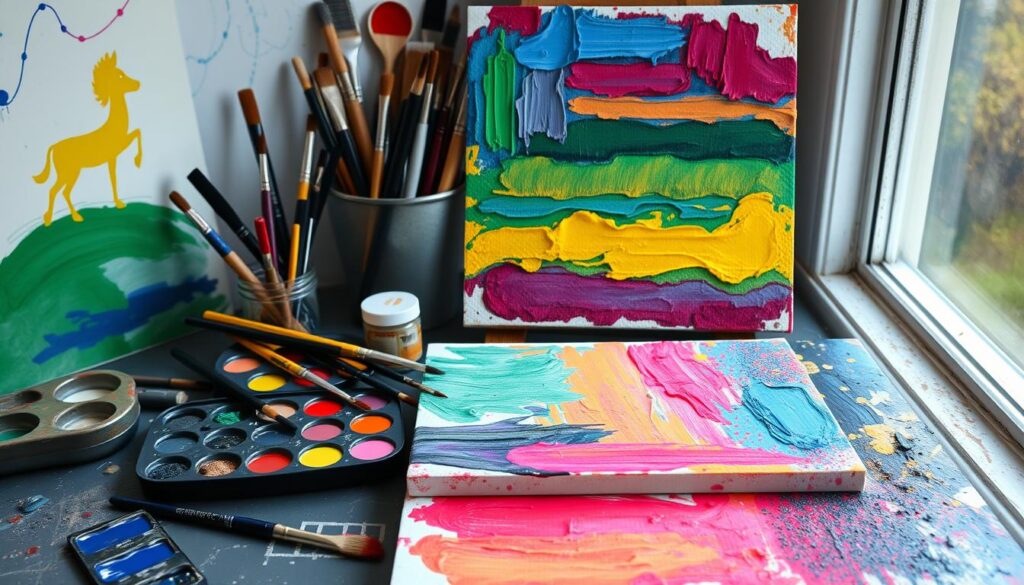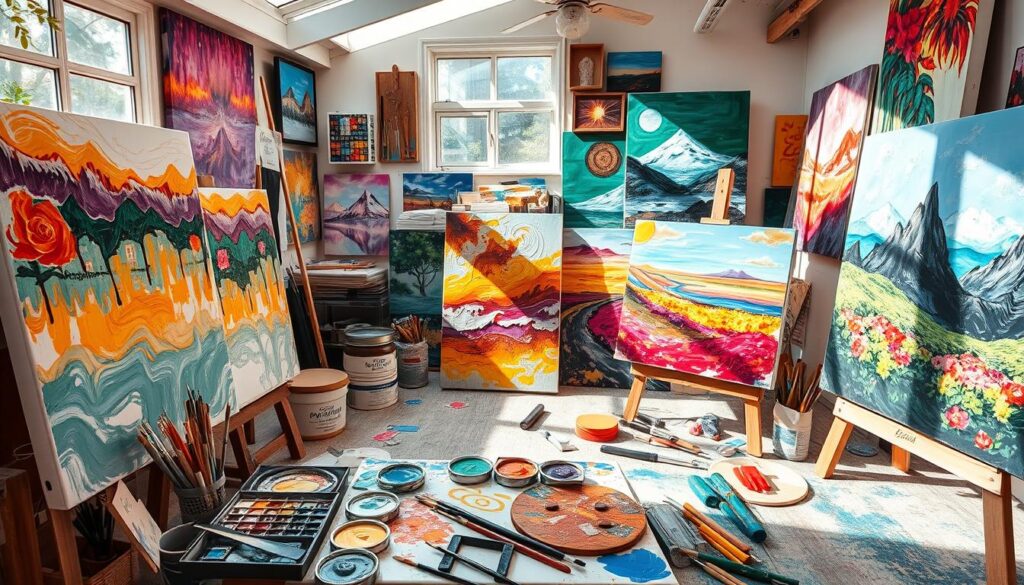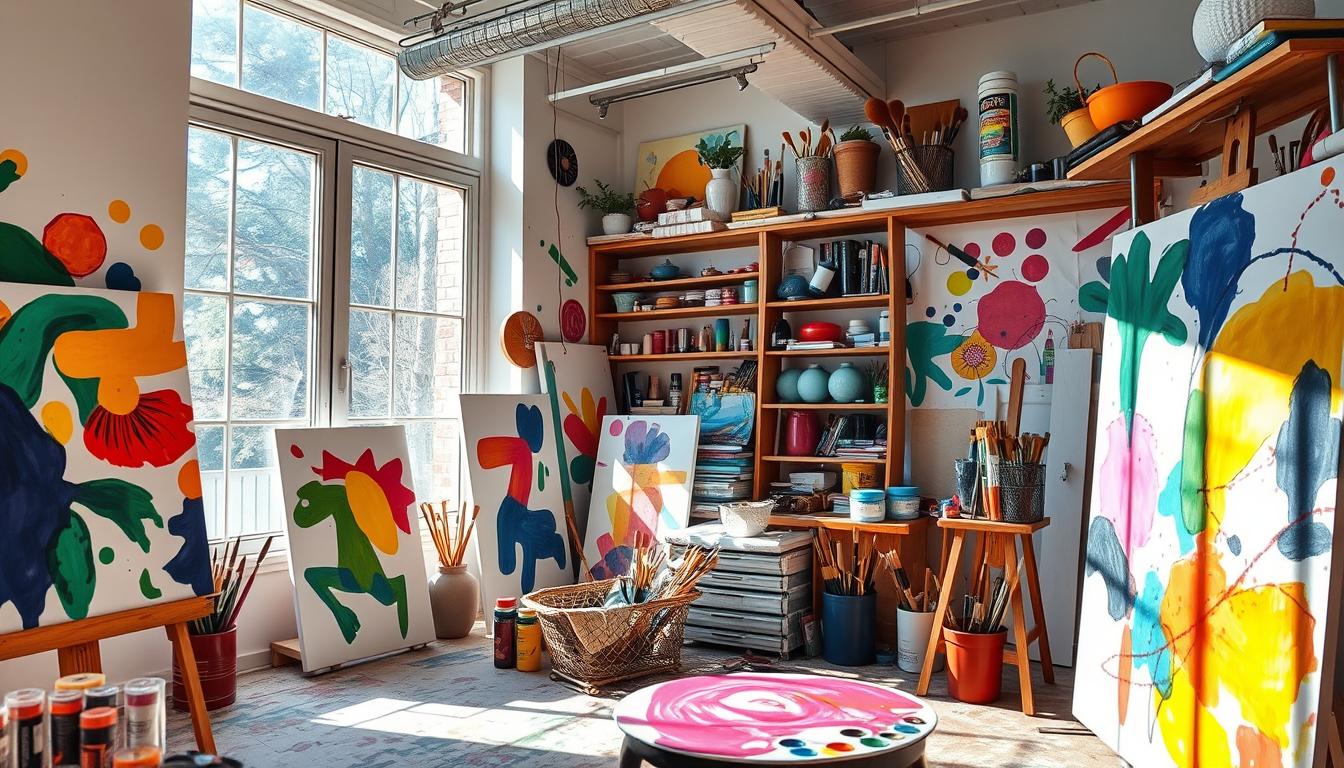This post contains affiliate links.
Is there a hidden artist inside you waiting to come out? Are you unsure how to start?
Acrylic painting is a great way to unlock your artistic potential. It’s perfect for both new artists and those wanting a new hobby. Acrylics dry fast and come in bright colors, letting you play with color, texture, and design.
To start, gather your basics: brushes, a palette, canvases or paper, and beginner paints. These tools are the foundation for exploring and practicing. Every brushstroke and mix of colors moves you closer to mastering acrylics and creating beautiful canvas creations.
Don’t worry about mistakes as you learn acrylics. They’re chances to grow and learn. We’ll also try more complex techniques to improve our art. Check out our acrylic painting guide for easy ideas and step-by-step tutorials to boost your skills and confidence.
Key Takeaways
- Acrylic paints dry quickly and offer vibrant colors, ideal for beginners.
- Investing in artist-grade paints results in richer, longer-lasting artworks.
- Using a variety of synthetic brushes enhances painting techniques.
- A canvas is a preferred surface, but experimentation with wood, paper, or metal is encouraged.
- Layering in acrylic painting adds dimension and depth through transparent and opaque layers.
- Advanced techniques like glazing and impasto enrich the texture and complexity of the artwork.
Join us on this thrilling journey into the world of acrylic painting.
Introduction to Acrylic Painting
Let’s dive into the world of acrylics and see why they’re so popular. Since the 1940s, acrylic paints have become a staple in the art world. They’re loved for their bright colors and flexibility. Whether you like realistic portraits or abstract art, acrylics are a great choice.
The versatility and appeal of acrylics
Acrylic painting basics show us that these paints dry fast, unlike oil paints. Thin layers dry in under an hour, and thicker layers dry within a day. This quick drying lets us layer our artwork easily, adding depth and texture.
Acrylics are also easy to clean with water because they’re water-based. This makes them a favorite for artists.
Acrylics come in different types, like heavy body and soft body paints. Heavy body paints are thick and creamy, while soft body paints are smooth. Brands like Winsor & Newton, Liquitex, and Golden offer high-quality paints with pure colors for bright artwork.
Essential materials and tools
To start with acrylics, you’ll need some basic supplies. Here’s what you’ll need:
- A set of acrylic paints: Look for brands like Winsor & Newton, Liquitex, M. Graham, Blick Studio, Arteza, and Artist’s Loft.
- Brushes: Choose synthetic brushes for beginners. They should have smooth bristles, keep their shape, and not shed paint.
- Canvas boards: Great for beginners because they’re easy to store and provide a good painting surface.
- Paper palettes: Good for mixing colors and cleaning up. A palette knife is useful for blending paint too.
- Cleaning supplies: Clean your brushes with water often to keep them from drying out and to extend their life.
Using a hair dryer can help speed up paint drying. For long painting sessions, keep a spray bottle and a container for your palette to keep the paint fresh overnight.
| Brand | Quality | Series Number |
|---|---|---|
| Winsor & Newton | Artist Quality | 1-4 |
| Liquitex | Artist Quality | 1-4 |
| Golden | Artist Quality | 1-4 |
| Daler-Rowney System3 | Student Quality | 1 |
| Galeria | Student Quality | 1 |
| Abstract Acrylics | Student Quality | 1 |
With these starter materials and basic knowledge, you’re ready to start your acrylic painting journey. Enjoy the flexibility, try new techniques, and explore the endless creative possibilities that acrylic painting offers.
Understanding Basic Acrylic Painting Techniques

Starting with acrylics means learning key painting techniques. These basics help artists be creative and make colorful, lively art. Let’s look at three main techniques that are crucial for acrylic painting.
Wet-on-Wet Method
The wet-on-wet acrylics technique lets us mix colors smoothly while they’re still wet. It’s great for skies or water scenes. Using heavy-body acrylic paint makes blending easier. Adding water or gel medium slows drying, allowing for smooth blending over big areas. For beginners, check out this guide for tips.
Dry Brushing
Dry brushing adds texture and fine details to paintings. By brushing dry paint onto the canvas, we get a rough look. It’s perfect for things like fur, grass, or bark. This method uses little paint, making it great for adding subtle touches without overwhelming the artwork.
Layering for Depth
Layering is key for adding depth to a painting. Acrylics dry fast, which is good for layering quickly. Each layer brings new details or colors, making the art richer. They dry darker, which helps with shadows and depth. Using transparent washes or glazes can make the art look brighter and more textured. Managing drying, like with a hair dryer or sunlight, can speed up the process.
Using these techniques can greatly improve an artist’s skills and creativity in acrylic painting. Whether you’re mixing colors with wet-on-wet, adding texture with dry brushing, or layering for depth, these basics are vital. For more tips and tutorials, look for guides made for beginners in acrylic painting.
Acrylic Painting Tips for Beginners
Starting with acrylic painting is both thrilling and a bit scary. With these tips, you’ll find it easier to start your acrylic journey. Let’s explore the basics that every new artist should know.
Choosing the right brushes and paints
Choosing the right brushes is key for your acrylic projects. A survey shows that 72% of beginners prefer synthetic brushes because they stick to the paint well. It’s smart to have brushes of different sizes, like small, medium, and large. For the best results, use artist-grade acrylic paints for their vibrant colors and durability.
Practicing brushstrokes and color mixing
Learning brushstrokes and color mixing is crucial for acrylic painting. Clean your palette often to keep colors bright and prevent mixing mistakes. Also, 69% of artists say blending colors is important because acrylics dry fast. Trying different brushstrokes and a few colors can help you learn and improve.
Embracing mistakes and learning from them
Every mistake is a chance to learn. You’ll face challenges in your acrylic painting, but they’re lessons. Many artists suggest stepping back from your work to see it with new eyes. Joining art groups can also give you support and helpful advice. Remember, every brushstroke helps you grow as an artist, so celebrate your progress.
| Tip | Explanation |
|---|---|
| Choose synthetic brushes | Effective for medium-bodied paint adherence; preferred by 72% of beginners |
| Practice mixing colors | Essential for controlling your palette; stressed by 69% of artists |
| Embrace mistakes | Opportunities for learning and growth in your creative process |
By following these tips and practicing, you’ll lay a strong foundation in acrylic painting. Remember, every artist started as a beginner. With hard work and patience, you’ll discover your artistic talent.
Exploring Different Acrylic Painting Styles
Acrylic painting lets us express ourselves in many ways. It suits both abstract painting fans and those who love realistic landscapes. This versatility makes it a favorite among artists.
Acrylics offer a wide range of techniques. For example, dry brushing creates soft, textured effects with little paint. The impasto technique lets us build thick, textured layers for depth. These methods help artists explore various acrylic painting styles and find new ways to be creative.
Developed in the 1940s, acrylics have become popular for their unique qualities. They blend the best of oil paints and watercolors, offering rich colors and flexibility. Artists can use them on many surfaces, like canvas, paper, wood, glass, and fabric.
Sgraffito is another exciting technique. It involves scratching into wet paint to show off colors underneath or make patterns. The glazing technique, which layers transparent colors, adds depth and light to our art.
“To create one’s world in any of the arts takes courage.” – Georgia O’Keeffe
For those who love mixing colors, exploring different techniques is key. Blending colors is crucial for realistic landscapes, making each stroke blend smoothly with nature. Techniques like dripping and acrylic pouring let us create spontaneous, abstract art, showing off acrylics’ versatility.
Here’s a look at some popular acrylic techniques:
| Technique | Description | Applications |
|---|---|---|
| Wet Brush on Dry Canvas | Applying wet paint on a dry surface | Smooth transitions, basic layers |
| Dry Brush | Using dry brush with minimal paint | Textured, subtle effects |
| Impasto | Thick, textured layers | 3D appearance, strong texture |
| Sgraffito | Scratching into wet layers | Revealing underlying layers, patterns |
| Glazing | Layering transparent colors | Depth, luminosity |
| Splattering | Flicking or splattering paint | Textural additions, energy |
| Palette Knife | Using a palette knife to apply paint | Thick, expressive strokes |
By trying out these techniques and exploring acrylic painting styles, we can improve our skills. We also find new ways to express our creativity.
Advanced Acrylic Painting Techniques
Improving your acrylic painting skills means trying out advanced techniques. These methods, like glazing with acrylics and the impasto effect, make your art richer and help you stand out. Let’s look at some advanced methods to boost your creativity.
Glazing for Luminosity
Glazing with acrylics means putting thin, clear layers of paint over a base layer. This creates a glowing effect in your paintings. By layering glazes, you can add depth and color shifts that make your art more interesting. Make sure each layer is dry before adding the next to keep colors clear.
Impasto for Texture
The impasto effect uses thick, raised layers of paint. This makes your art feel three-dimensional and grabs the viewer’s attention. Use a palette knife or a brush full of thick acrylics to shape the paint into dramatic patterns.
Acrylic Pouring
Acrylic pouring is a fun way to make abstract art. It mixes paint with a special medium to make it flow like liquid. By controlling how the paint spreads on the canvas, you can create beautiful, random patterns. Just remember to protect your work area and wear gloves, as it can get messy.

Using advanced techniques like glazing, impasto, and acrylic pouring can really make your art stand out. These methods help add light, texture, or patterns to your work. They open up a world of possibilities for expressing yourself creatively.
| Technique | Description | Tools |
|---|---|---|
| Glazing | Applying thin layers of translucent paint to build up luminosity and depth. | Soft brushes, thinned acrylics |
| Impasto | Using thick layers of paint to create texture and dimension. | Palette knife, heavy-bodied acrylics |
| Acrylic Pouring | Mixing paint with a pouring medium to create fluid, marbled effects. | Pouring medium, silicone oil, cups, stir sticks |
Choosing the Right Supplies for Acrylic Painting
Starting your acrylic painting journey means picking the right artist supplies. It’s important to know about quality brushes and paints, and to try different painting surfaces. These choices can greatly affect your art.
Selecting Artist-Grade versus Student-Grade Paints
Deciding between artist-grade and student-grade paints is key. Artist-grade paints have deeper colors and are more consistent but are pricier. Golden and Winsor & Newton are top choices for artist-grade paints.
Student-grade paints like Liquitex Basics and Amsterdam are more affordable. They have good color quality and are perfect for beginners.
The Importance of Quality Brushes
Good brushes are crucial for applying acrylics. Synthetic brushes are easy to clean, and flat and round brushes help with different strokes. Beginners might start with Artist Loft brushes, while pros prefer high-end brushes for precision.
Exploring Different Painting Surfaces
Canvas is popular, but trying other surfaces can add texture to your art. Thick watercolor paper, around 300 lb, is versatile and not too expensive. Wood, metal, and paper also offer unique effects, broadening your creative options.
| Paint Type | Brand | Pigment Quality | Consistency | Suggested Use |
|---|---|---|---|---|
| Artist-Grade | Golden | High | Rich | Finished Pieces |
| Student-Grade | Liquitex Basics | Moderate | Good | Learning & Experimenting |
Your choice in art materials, from top-quality brushes and paints to various surfaces, shows your style and creative dreams. Enjoy the process and let your supplies spark your next acrylic painting project.
Step-by-Step Tutorial: Creating a Landscape Painting
Starting a landscape painting with acrylics can change our art journey. This guide will show us how to sketch, apply colors, and add details. By the end, we’ll have a beautiful landscape inspired by New Zealand’s stunning views.
Sketching the Basic Outline
The first step in creating a great landscape is sketching. Use a 3B pencil to draw the main parts: the river, mountains, and skies. This sketch helps keep the composition right and guides the color later.
Mixing and Applying Colors
When mixing and applying colors, focus on key colors like Burnt Umber, Ultramarine Blue, Cadmium Yellow Light, and Permanent Alizarin Crimson. Artists like Samuel Earp suggest choosing the right colors for a beautiful painting. For a rich look, use artist-quality paints like Titanium White.
Here’s a helpful table for some suggested supplies:
| Paint Color | Brush Type | Usage |
|---|---|---|
| Burnt Umber | Size 6 Isabey Isacryl acrylic brush – filbert | Initial Blocking |
| Ultramarine Blue | Size 10 Isabey memory brush – round | Sky and Water |
| Cadmium Yellow Light | Size 10 Isabey memory brush – round | Highlights |
| Permanent Alizarin Crimson | Size 6 Isabey Isacryl acrylic brush – filbert | Accents |
Adding Details and Finishing Touches
Details bring a landscape to life. Look closely to find the lightest and darkest parts of your painting. Use special brush techniques for a unique look in trees and water.
Adding touches of sunshine orange can make buildings pop, like the roofs in a Provence landscape. Following these steps helps us make a stunning landscape painting that captures nature’s beauty.
Inspirational Acrylic Painting Ideas for Artists
As artists, finding creative inspiration can sometimes be tough. But exploring different painting ideas can open up new possibilities and sharpen our artistic vision. Here are some exciting ideas to spark your creativity.
- Joyful Abstracts: Try the Joyful Abstracts class on Skillshare. It offers unique techniques and a free month-long trial, perfect for beginners.
- Acrylic Finger Painting: Get creative with a blog tutorial on acrylic finger painting. This method can lead to unique and expressive art.
- Monstera Leaf Painting: Paint vibrant monstera leaves in a special class. It’s great for those wanting to mix acrylic paint with other mediums for unique art.
- Art Heart Painting: Paint radiant hearts in the Art Heart class. This lesson focuses on techniques that boost emotional expression in your art.
- Exploring Still Lifes: Practice with still lifes to improve your observation skills. Use everyday objects and play with lighting to add depth and realism.
For better results, use artist-grade paints for their richer colors. Synthetic brushes are also a good choice for acrylics because they last long. Make sure to clean your brushes often to avoid paint hardening. The wet-on-wet method is great for blending colors smoothly.
For beginners, start with a few colors to focus on mixing and creating a cohesive piece. These tips and projects can make learning fun and help you grow as an artist.
Conclusion
Our journey into acrylic painting shows its power to change us. It starts with basics like brushwork and layering. Then, we move to advanced techniques like glazing and impasto. Each step helps us grow creatively.
Acrylic painting is easy to start with and very flexible. It’s loved for being affordable, drying fast, and having colors that stay bright. Many artists choose it for these reasons.
Starting with acrylic painting opens up many possibilities. Beginners can learn basic techniques to become masters. Experienced artists can try new styles and methods.
Learning doesn’t have to be alone. Joining an art community, finding a mentor, and using free online tutorials can help us improve.
Every canvas shows our growth and creativity. By trying new things and improving our skills, we can do amazing things. Acrylic painting lets us express ourselves and explore our creativity.
As we keep growing, let’s celebrate our successes. Let’s look forward to all the new things we can create.
FAQ
What makes acrylic paint a versatile art medium?
What starter materials are essential for acrylic painting?
What is the wet-on-wet method in acrylic painting?
How does dry brushing work in acrylic painting?
Why is layering important in building depth in acrylic paintings?
How do I choose the right brushes and paints as a beginner?
Why should I practice brushstrokes and color mixing?
How can embracing mistakes benefit my artistic growth?
What styles can I explore with acrylic painting?
What advanced techniques can enhance my acrylic paintings?
How do I choose between artist-grade and student-grade paints?
Why are quality brushes important for acrylic painting?
What are some different painting surfaces I can use besides canvas?
How do I start a landscape painting step-by-step?
What are some inspirational acrylic painting ideas for artists?
This post contains affiliate links.

